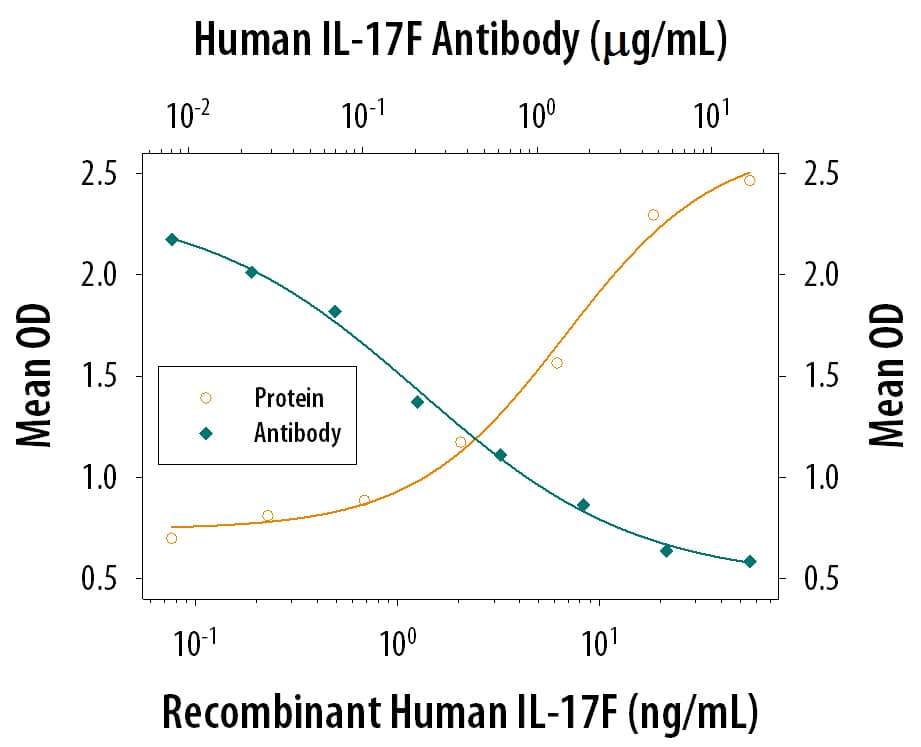Human IL-17F Antibody
R&D Systems, part of Bio-Techne | Catalog # MAB13352

Key Product Details
Species Reactivity
Validated:
Cited:
Applications
Validated:
Cited:
Label
Antibody Source
Product Specifications
Immunogen
Gly21-Thr153
Accession # Q96PD4
Specificity
Clonality
Host
Isotype
Endotoxin Level
Scientific Data Images for Human IL-17F Antibody
IL-6 Secretion Induced by IL‑17F and Neutralization by Human IL‑17F Antibody.
Recombinant Human IL-17F induces IL-6 secretion in the NIH-3T3 mouse embryonic fibroblast cell line in a dose-dependent response (orange line), as measured by the Mouse IL-6 Quantikine kit (Catalog # M6000B). Under these conditions, IL-6 secretion elicited by IL-17F is neutralized (green line) by increasing concentrations of Mouse Anti-Human IL-17F Monoclonal Antibody (Catalog # MAB13352). The ND50 is typically 0.1-0.6 µg/mL.Applications for Human IL-17F Antibody
Neutralization
Reviewed Applications
Read 2 reviews rated 5 using MAB13352 in the following applications:
Formulation, Preparation, and Storage
Purification
Reconstitution
Formulation
Shipping
Stability & Storage
- 12 months from date of receipt, -20 to -70 °C as supplied.
- 1 month, 2 to 8 °C under sterile conditions after reconstitution.
- 6 months, -20 to -70 °C under sterile conditions after reconstitution.
Background: IL-17F
The Interleukin 17 (IL-17) family proteins, comprising six members (IL-17A through IL-17F), are secreted, structurally related proteins that share a conserved cystine‑knot fold near the C-terminus, but have considerable sequence divergence at the N-terminus. With the exception of IL-17B, which exists as a non-covalently linked dimer, all IL-17 family members are disulfide-linked dimers. IL-17 family proteins are pro-inflammatory cytokines that induce local cytokine production and are involved in the regulation of immune functions (1, 2).
Human IL-17F cDNA encodes a 163 aa protein with a putative 30 aa signal peptide. Among IL-17 family members, IL-17F is most closely related to IL-17A (approximately 44% aa sequence homology), but shares only limited sequence homology (16 - 30%) with IL-17B, C, D and E. Human and mouse IL-17F share 55% sequence identity. IL-17F is expressed in activated CD4+ T-cells and activated monocytes. Five receptors (IL-17 RA, B, C, D and E) have been identified (5). Although the ligands for IL-17 RD and E are not known yet, it is reported that IL-17 RA binds IL-17A, and IL-17 RB binds IL-17B and IL-17E. IL-17 RC binds IL-17A and IL-17F with similarly high affinity and functions as a receptor for both IL-17A and IL-17F (5, 6). The biological activities mediated by IL-17F are similar to those of IL‑17. IL‑17F stimulates production of IL-6, IL-8, G-CSF, and regulates cartilage matrix turnover by increasing matrix release and inhibiting new matrix synthesis (4). IL‑17F also inhibits angiogenesis and induces production of IL-2, TGF-beta, and monocyte chemoattractant protein-1 in endothelial cells (3).
References
- Aggarwal, S. and A.L. Gurney (2002) J. Leukoc. Biol. 71:1.
- Moseley, T.A. et al. (2003) Cytokine & Growth Factor Rev. 14:155.
- Starnes, T. et al. (2001) J. Immunol. 167:4137.
- Shen, F. & S. L. Gaffen (2008) Cytokine 41:92.
- Kuestner, R.E. et al. (2007) J. Immunol. 179:5462.
Long Name
Alternate Names
Gene Symbol
UniProt
Additional IL-17F Products
Product Documents for Human IL-17F Antibody
Product Specific Notices for Human IL-17F Antibody
For research use only
